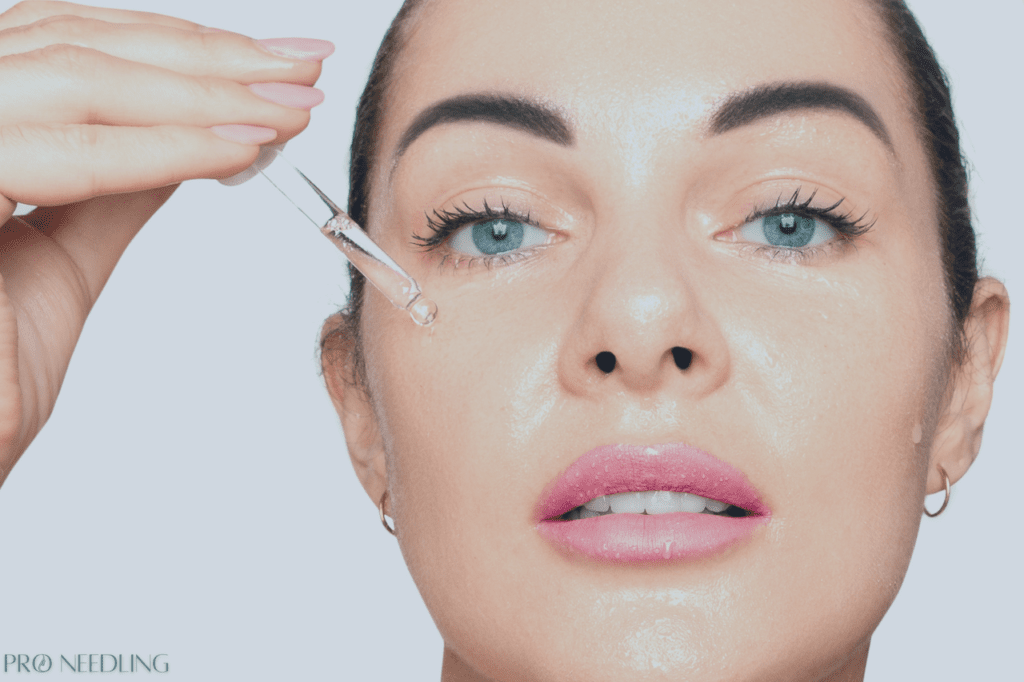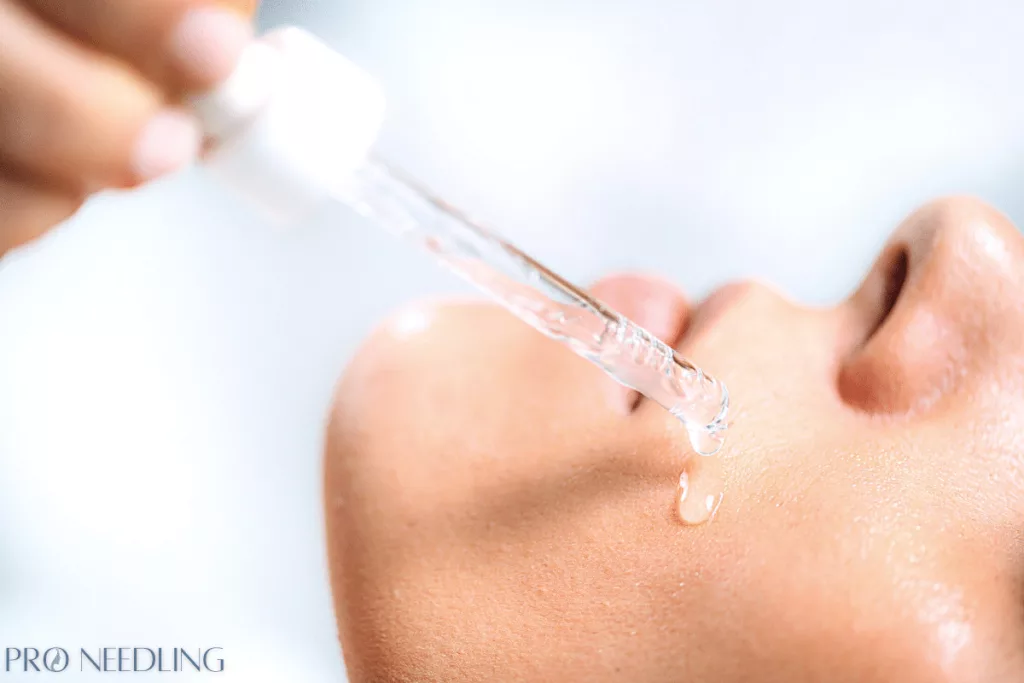Unlock the secrets of a flawless complexion as we delve into the transformative realm of microneedling with hyaluronic acid. This dynamic duo combines the rejuvenating prowess of microneedling’s controlled skin punctures with the unparalleled hydration and plumping effects of hyaluronic acid. Whether you’re a skincare enthusiast seeking a revitalized visage or aiming to diminish fine lines and scars, microneedling with hyaluronic acid offers a promising path to skin perfection. In this article, we’ll explore the science, benefits, and best practices of this innovative skincare approach, unveiling a radiant new you.

Related Articles:
What Is Microneedling With Hyaluronic Acid?
Microneedling with hyaluronic acid is a cosmetic procedure that combines the benefits of traditional microneedling with the hydration and rejuvenation properties of hyaluronic acid (HA). Microneedling, also known as collagen induction therapy, involves using a device with fine, sterile needles to create controlled micro-injuries on the skin’s surface.
These micro-injuries stimulate the skin’s natural healing processes, including collagen and elastin production, leading to improved skin texture, tone, and overall appearance. While microneedling alone will provide many benefits for the skin, adding a hyaluronic acid serum to the process can provide many advantages.
Why Should You Use Hyaluronic Acid with Microneedling?

Hyaluronic acid is the top-recommended serum for microneedling as it plays a crucial role in maintaining tissue hydration, lubrication, and overall skin health.
The combination of microneedling and hyaluronic acid can offer several powerful benefits:
Since it is naturally occurring in the body, it has a very low risk of causing an allergic reaction.
- Enhanced Hydration: Hyaluronic acid’s hydrating benefits improve skin moisture levels, adding plumpness and nourishment when the skin may be more sensitive and prone to dryness after treatment.
- Lubrication: ensures a seamless glide of the microneedling tool across the skin’s surface, minimizing the risk of any tearing or ripping.
- Skin Rejuvenation: Since microneedling improves the absorption of skincare products, HA not only nourishes the skin but provides beneficial nutrients into the skin channels that can enhance results. Hyaluronic acid reduces the signs of skin degeneration and mitigates the effects of aging by working along with microneedling. This can lead to improved skin texture, reduced fine lines, and a more youthful appearance.
- Minimized Downtime: The soothing properties of HA can help reduce and calm redness, irritation, bruising, and discomfort after microneedling. It can also escalate the process of healing and cell repair, minimizing the downtime or recovery period.
What is Hyaluronic Acid?
Hyaluronic acid (HA) is offered as a serum, powder, supplement, or injectable and plays an important role in combating aging. It helps regulate inflammation, contains antioxidant properties, and helps with the tissue repair process.
Hyaluronic acid is a naturally occurring sugar found within the body, a powerful humectant that holds 1000x its weight in water. The special feature of the hyaluronic acid molecules is that they have a tendency to bind with water along with absorbing it. It’s fair to say that skin hydration and hyaluronic acid go hand in hand.
These hydrating benefits give the desired plumpness and fullness to the skin, which provides the ability to retain elasticity or firmness, which reduces the chances of wrinkling. As the body ages, the slowed hyaluronic acid production in our bodies ultimately results in folds and wrinkles. Hence why we have to administer nourishing hyaluronic acid externally to meet the skin’s demand.
How To Choose a HA Serum
Not all hyaluronic acids hold the same quality. They should be free of fragrances, preservatives, alcohol, parabens, active ingredients, and other irritating ingredients. Consult a dermatologist on what would be best for your specific skin type.
For medical needling (needling at .5mm or more) use a high molecular weight hyaluronic acid. This is not only ideal for a lubricant but also for its anti-inflammatory properties. It helps with healing, collagen production, and moisturizing. This should only be applied during or after treatment.
For cosmetic needling, (needling below .5mm) using a mixed-weight hyaluronic acid serum is ideal. This is generally for users microneedling at home and derma rolling at short lengths.
Related Article: THE BEST HYALURONIC ACID SERUMS FOR MICRONEEDLING
Hyaluronic Acid Before and After Microneedling
“Do I use hyaluronic acid before microneedling or after?”
You can apply hyaluronic acid topically before and after the microneedling process. Hyaluronic acid is usually applied before microneedling as a lubricant to guide your microneedling device over a smooth surface. This helps to avoid the risk of skin tearing that can happen when microneedling on dry skin.
You can also apply hyaluronic acid after microneedling for the nutrient and nourishing skincare benefits. The channels or punctures created by the needling allow for better absorption deep into the skin’s surface. It can help stimulate collagen production and other growth factors.

Microneedling For Youthful Skin: How It Works
The use of the hair-thin needles to create punctures in the skin prompts the healing cascade in our cells and the well-programmed system in our body commences the healing process. This promotes new collagen formation, elastin production, and amplifies the new cell formation, thereby resulting in improved skin tone and texture.
Providing nourishing hyaluronic acid, or another topical agent onto the micro-pores formed during needling, provides a profound hydration effect to the skin’s deeper layers. Microneedling has shown promising results in treating acne scars, pigmentation, deep wrinkles, stretch marks, and fine lines. It can also bring a glow and radiance to your newly hydrated skin while reducing pore size and visible signs of aging.
How Many Treatments Will I Require?
The total number of microneedling treatments required for each individual will vary and be influenced by numerous factors. For instance, the skin conditions being treated play a major role in deciding if you will need one or multiple sessions.
The history of your skin and various lifestyle factors also contribute to deciding the number of microneedling treatments required. Most people experience astounding results with just a single session, while others may need multiple treatments to achieve their desired result.
It takes roughly 4 to 6 weeks before skin cells complete a cell cycle required to show its maximum effects. It is safe to get your next microneedling treatment after taking a break of 4 to 6 weeks.
The Molecular Weight of Hyaluronic Acid

In the context of microneedling, different molecular weights of hyaluronic acid can have varying effects on the skin due to its penetration capabilities and interactions with the skin’s layers. The molecular weight of hyaluronic acid refers to the size of its individual molecules, typically measured in Daltons (Da).
Different molecular weights penetrate different levels of the skin. Molecules with lower molecular weight are smaller, and can therefore reach the deeper layers of skin.
Dermatologists generally recommend high molecular weight hyaluronic acid should be used during needling over .5mm. Mixed-weight hyaluronic acids can be used below .5mm.
While many brands claim that their products are 100% hyaluronic acid solutions, this does not mean the concentration is 100%. A solution of 100% concentrated HA wouldn’t be advisable to apply to your face or skin. Generally, most products hold between 1-2% pure hyaluronic acid serum solution.
Summary
Embarking on a journey toward skin perfection, the fusion of microneedling and hyaluronic acid unlocks a realm of transformative skincare. This dynamic partnership intertwines the art of controlled skin punctures with the rejuvenating effects of hyaluronic acid, offering a promising route to a revitalized visage. Whether your goal is to diminish scars, fine lines, or to embrace overall skin renewal, the microneedling and hyaluronic acid synergy holds the key.
FAQ
Can I Use Hyaluronic Acid With Dermaroller?
Of course! You can apply this topical hydrating product directly to your skin before for a lubricant and after dermarolling to absorb the powerful nutrients.
What Areas Can Be Treated With Microneedling and Hyaluronic Acid?
Microneedling with Hyaluronic acid can be used to treat multiple areas of the body such as the face, arms, hands, and neck. It’s also suitable for use on all skin types.
